Rare NEW ZEALAND Pattern 1875 SNIDER Carbine SAWBACK Rifle SWORD Skinnerton N1#2
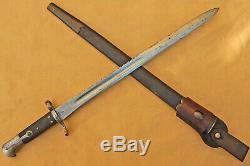



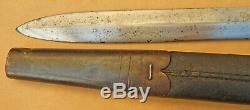
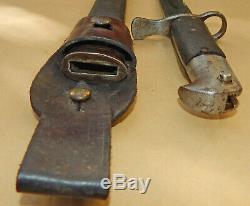
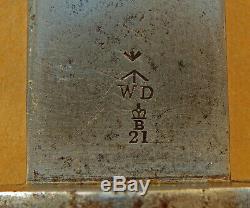
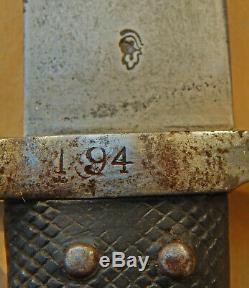

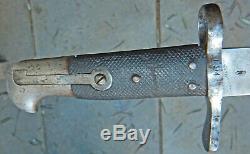

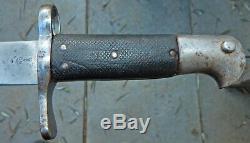

MUZZLE RING size = 21 mm or 0.8270. BLADE = 458 mm overall length = 610 mm (In scabbard). SERIAL NUMBERED # 194 which likely indicates a LOW total ISSUE (Believed to be LESS than 2000). Retains BOTH scabbard (Double Broad-Arrow marked = "S-O-S") and has the very rare FROG.
(Most Sniders today do not have extant leather scabbards, as they are 150 years old). This is a VERY SCARCE Commonwealth bayonet USED ONLY here in NEW ZEALAND. The advent of the Snyder into the British service saw it's use in New Zealand, by the Imperial troops and Volunteers, and the Snyders were beginning to arrive in New Zealand by the end of the second Maori War.
You WILL FIND IT in "British & Commonwealth Bayonets" by Ian Skennerton & Robert Richardsen. (ALL THREE versions of this ULTRA RARE bayonet are covered Pages # 356 - 361). Where it is catalogued as "N1" and has been expertly described as..... This is the FIRST TYPE made in Solingen by Kirschbaum, and thus marked on the ricasso with the Knight's Helm.
Also has Birmingham inspection marks and The WAR DEPARTMENT's mark. UNLIKE the British issue sawback bayonets, this is a BAR ON BARREL model so the muzzle ring is level with the tang. Saw teeth along the back edge, Double-edge point. Knurled leather grips secured by 4 rivets.The FIRST TYPE (this one) had an 18.1 blade length and an MRD (Muzzle Ring Diameter) of 20.00 mm. The 2nd type (N2) had a LONGER 20.25 blade. The 3rd type (N3) was the Snyder sawback bayonet BAR ON BAND type with an 18 blade.
New Zealand's first sizeable orders for rifles, carbines, and bayonets commenced in the mid-1870s and the most popular was the Snyders. Even in the 1890s there was no regular issue of the Martini-Henry and the first Martini rifles or carbines to see general use were the. 303 Martini Enfields at the turn of the 20th Century. SOME of the New Zealand Snyders were ordered with a special bayonet, the sawback sword type.
The 18 blade sawback bayonet was introduced into service in Britain with the Irish Constabulary model in 1868 and then this pattern was used with the trials Martini-Henry long-chamber rifles in 1869. When a pattern was approved for the Martini-Henry rifle in 1875, the 18" blade model was manufactured at first, but the WRONG blade length had been sealed, as it had been INTENDED to seal the model with a 20" blade. The longer blade was then manufactured as the correct pattern, although the sawback bayonet was not widely issued with the Martini rifles. Following this trend, New Zealand ordered sawback bayonets with its short Snyder rifles, but this bayonet was not in production in England at the time of the order (1873) and the only models on issue were to the Irish Constabulary.
So, the bayonets were ordered from the German trade, who supplied many British sword bayonets and the contract was filled by Kirschbaum in Solingen. The New Zealand contract SNIDER SAWBACK BAYONET is classified as the FIRST TYPE and shown as "N1". A distinction has been made between two types as there were two different contracts, and for different Snyders. The stand numbers, which are matched to the accompanying rifle, are marked on the crosspiece, and the specimens examined have been recorded with numbers between the high 700's and 2091.
Exact quantities and dates of the contracts for these sawback bayonets are not easy to ascertain; most of the documentation in New Zealand which relates to this period was destroyed in Wellington when State Legislature Buildings were burned down in 1907. BSA records indicate an order for 2000 Snyder short rifles and sawback bayonets and scabbards being passed on from the War Office, and this is reported to have been for New Zealand. The last contract (April 1860) was lost to C. Bonehill of Birmingham, who tendered a lower price, and the reason for the requirement "without bayonets" was because these were being supplied from War Department stores. It is obvious that not all the rifles and artillery carbines were supplied with bayonets, and probable that not all the sword bayonets supplied were the sawback types, but the more usual British Yataghan models.
The sawback bayonets were ordered through the War Office and so they were inspected at R. Birmingham and marked with the Birmingham view mark. Contract bayonets have the 18" blade, as the 20" version was not introduced into British service until 1875.
While the available records do not agree when it comes to the quantities and bayonets are not adequately described, it is concluded that the 1874 batch of 2,000 rifles from B. Were those supplied with the sawback bayonets, and these may well have been ordered from the War Office as early as 1871. A further 600 short rifles with sawback bayonets appear to have been bought in 1875, while the 1878 and 1879 orders for 1,000 and 2,000 short rifles respectively, were more likely to have been issued with the yataghan bayonet. These bayonets have the scabbard with the early style of chape, which was a squared end.
The rounded tip was not introduced until July, 1980, and this is a feature of the scabbards of the longer 2nd Type (N2) 20.25 blade. The 1st type of New Zealand sawback fixes to the Snider short rifle, which is a bar on barrel model, and so the muzzle ring is close to the hilt. The back edge of the hilt and grips are slightly concave so as to allow for the shape of the rifle barrel. The British sawback bayonets for the Irish Constabulary carbine, trials Martini-Henry and the Martini-Henry in 1875 ARE ALL Bar on Band models. The condition has been shown faithfully in the many photographs in my listing These IMAGES ARE my actual CONDITION DESCRIPTION So if I have failed to show anything clearly?
Any questions please MESSAGE ME. Receipt will be issued on request. The item "Rare NEW ZEALAND Pattern 1875 SNIDER Carbine SAWBACK Rifle SWORD Skinnerton N1#2" is in sale since Sunday, July 21, 2019.
This item is in the category "Collectibles\Militaria\WW I (1914-18)\Original Period Items\Australia, ANZAC". The seller is "phillip_in_new_zealand" and is located in Auckland (aprox. 12,000 "clicks" from USA). This item can be shipped worldwide.
- Country/Region of Manufacture: Germany

